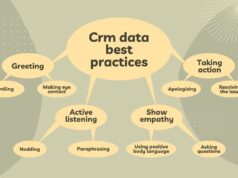CRM data entry remains one of the most overlooked aspects of business operations. Many organizations invest in sophisticated CRM platforms but fail to implement proper data entry protocols, resulting in incomplete, inconsistent, or outdated information that compromises the system’s effectiveness.
The Critical Role of CRM Data Entry in Business Success
This comprehensive guide explores the fundamental importance of meticulous CRM data entry practices, common challenges faced by organizations, and proven strategies to optimize your data management processes. Whether you’re a small business owner, sales manager, or CRM administrator, understanding these principles will help transform your customer data into a powerful asset for business intelligence and growth.
Why CRM Data Entry Quality Makes or Breaks Your Business Intelligence
The Foundation of Customer Insights
Your CRM system is only as good as the data it contains. High-quality, accurate data entry serves as the foundation for all customer insights and business intelligence derived from your CRM. When data is entered completely and consistently, your organization can:
- Develop comprehensive customer profiles that reveal buying patterns and preferences
- Identify trends and opportunities that might otherwise remain hidden
- Make data-driven decisions based on reliable information
- Personalize customer interactions across all touchpoints
According to a study by Gartner, businesses with high-quality data realize up to 35% more revenue from their CRM initiatives compared to those with poor data quality. This difference highlights how proper data entry directly impacts your bottom line.
The Cost of Poor Data Entry Practices
Conversely, poor CRM data entry practices can severely hinder your business operations. The repercussions include:
- Missed sales opportunities due to incomplete customer information
- Inaccurate forecasting and planning based on flawed data
- Decreased employee productivity as staff waste time searching for or correcting information
- Diminished customer experience resulting from personalization failures
- Eroded trust in the CRM system, leading to reduced adoption rates
Research from Data Entry Ninja reveals that bad data costs businesses an average of 15% to 25% of their revenue. Additionally, IBM estimates that poor data quality costs the US economy over $3.1 trillion annually.
Common CRM Data Entry Challenges Organizations Face
Data Duplication and Inconsistency
One of the most prevalent issues in CRM systems is duplicate records. This problem occurs when multiple entries exist for the same customer, contact, or opportunity. Duplication creates confusion, wastes storage resources, and makes it difficult to maintain a single source of truth about your customers.
Inconsistent data formatting compounds this issue. When different team members enter information in varying formats—such as recording phone numbers as (555) 123-4567 versus 555-123-4567—it becomes challenging to search, sort, and analyze data effectively.
Incomplete Information and Data Gaps
Partial data entry creates significant gaps in your customer intelligence. When sales representatives or service agents hurriedly enter only the minimum required fields, valuable context is lost. These information gaps limit your ability to:
- Understand the customer’s complete history with your company
- Identify cross-selling or upselling opportunities
- Segment customers effectively for marketing campaigns
- Provide personalized service experiences
Manual Entry Errors and Typos
Human error is inevitable in manual data entry processes. According to research by the Data Warehousing Institute, human error accounts for approximately 60% of data quality issues. Simple typos in email addresses, company names, or contact information can have significant consequences, from failed communications to missed opportunities.
User Adoption and Consistency Challenges
Perhaps the greatest challenge to effective CRM data entry is ensuring consistent adoption across your organization. When employees perceive data entry as burdensome or fail to see its value, they may:
- Enter minimal information just to “check the box”
- Delay updates until weekly or monthly batches
- Store customer information in personal spreadsheets or notes
- Create workarounds that bypass the CRM system entirely
Essential Best Practices for Optimizing CRM Data Entry
Establish Clear Data Entry Standards and Protocols
Creating and enforcing standardized data entry protocols is fundamental to CRM success. These standards should include:
- Required fields for different record types (contacts, accounts, opportunities)
- Naming conventions for companies, contacts, and products
- Formatting guidelines for phone numbers, addresses, and other common fields
- Classification systems for industry segments, lead sources, and customer types
Document these standards in a comprehensive style guide and make it easily accessible to all CRM users. Regular training sessions on these protocols will ensure team members understand not just what to enter, but why it matters.
Implement Data Validation Rules and Automation
Modern CRM systems offer powerful tools to enforce data quality through validation rules and automation. Consider implementing:
- Field-level validation that prevents incorrect formats or values
- Duplicate detection and merging capabilities
- Auto-population of fields based on existing information
- Data enrichment through third-party integrations
- Required field rules that prevent record creation without critical information
As noted by Salesforce Research, organizations using data validation tools report 28% higher data accuracy rates than those relying solely on manual processes.
Streamline the Data Entry Process
Simplifying data entry reduces user resistance and improves adoption rates. Strategies to streamline the process include:
- Customizing CRM layouts to show only relevant fields for specific user roles
- Creating intuitive data entry forms with logical field ordering
- Implementing progressive profiling to collect information incrementally
- Utilizing templates for common scenarios to speed up data entry
- Providing keyboard shortcuts and bulk update capabilities
Remember that every additional field or step in your data entry process decreases the likelihood of complete and accurate information. Focus on capturing essential data first, then expand as needed.
Leverage Technology for Data Capture and Entry
Take advantage of modern technology to minimize manual data entry requirements:
- Mobile CRM apps allow for real-time data entry during or immediately after customer interactions
- Business card scanning technology can automatically create contact records
- Email integration can capture communication history without manual logging
- Voice recognition can enable hands-free notes and updates
- Web-to-CRM forms can automatically create records from website submissions
According to research from DataEntryNinja.com, businesses that implement automated data capture solutions see an average 67% reduction in data entry time and a 42% improvement in data accuracy.
Regular Data Auditing and Cleansing
Even with the best initial entry practices, CRM data requires ongoing maintenance. Implement a regular schedule for:
- Running duplicate detection reports and merging redundant records
- Updating or removing outdated information
- Filling in missing data for high-value accounts
- Standardizing inconsistent formatting
- Verifying contact information for key relationships
Many organizations benefit from assigning specific team members as “data stewards” responsible for monitoring and maintaining data quality within their departments.
Measuring and Improving CRM Data Entry Quality
Key Performance Indicators for Data Quality
To improve your CRM data entry practices, establish measurable quality indicators:
- Completeness rate: Percentage of records with all critical fields completed
- Duplication rate: Number of duplicate records identified per month
- Error rate: Percentage of records containing incorrect information
- Timeliness: Average time between customer interaction and data entry
- Adoption rate: Percentage of team members consistently using the CRM
Track these metrics over time to identify trends and areas for improvement. Celebrate improvements and recognize team members who consistently maintain high data quality standards.
Creating a Data-Driven Culture
Beyond tools and protocols, successful CRM data entry requires cultivating a data-driven organizational culture:
- Demonstrate the value of quality data by showcasing insights and improvements derived from the CRM
- Incorporate CRM usage and data quality into performance evaluations
- Share success stories where accurate data led to business wins
- Establish feedback mechanisms for users to report data issues or suggest improvements
- Involve end-users in CRM decisions and enhancements
Advanced CRM Data Entry Strategies for Competitive Advantage
Integration with Other Business Systems
For maximum efficiency, integrate your CRM with other critical business systems:
- Marketing automation platforms to capture lead information
- E-commerce systems to record purchase history
- Support ticketing systems to track customer issues
- Financial systems to monitor customer value
- Social media platforms to capture engagement data
These integrations create a comprehensive view of customer interactions across all touchpoints while reducing manual data entry requirements.
Predictive Data Entry and AI Assistance
Emerging technologies are transforming CRM data entry through intelligent assistance:
- AI-powered suggestions that predict likely values for fields based on existing data
- Smart forms that adapt based on previous entries and customer segments
- Automated data enrichment that pulls additional information from public sources
- Natural language processing that extracts key details from emails and notes
- Machine learning algorithms that identify potential data quality issues
According to Harvard Business Review, companies utilizing AI-assisted data entry report 37% faster record creation and 29% higher data quality scores.
Transforming CRM Data Entry from Burden to Business Advantage
When approached strategically, CRM data entry evolves from an administrative burden to a competitive advantage. By implementing the best practices outlined in this guide—establishing clear standards, leveraging automation, streamlining processes, and fostering a data-driven culture—your organization can transform raw customer information into actionable business intelligence.
Remember that CRM data entry is not a one-time project but an ongoing commitment to information excellence. Invest in your data quality today, and you’ll build a foundation for superior customer relationships, more effective operations, and sustainable business growth for years to come.
For more specialized guidance on optimizing your CRM data management processes, visit DataEntryNinja.com for expert resources and solutions tailored to your industry needs.








